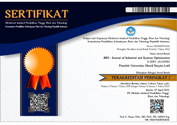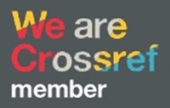PERBAIKAN SISTEM KERJA PADA DIVISI PACKING PRODUK RACK TROLLEY DENGAN METHOD TIME MEASUREMENT (MTM)
DOI:
https://doi.org/10.51804/jiso.v4i2.96-101Keywords:
motion element, mtm, packing process, standard timeAbstract
The work system is the most important thing in the company, especially in manufacturing companies that produce various kinds of kitchen utensils made from stainless steel 402 and stainless steel 201 according to market demand. Of the many existing products, there are products with the highest demand level but take a long time in the packing division, which only has one station. The MTM (Method Time Measurement) method is used to map work movements that focus on work elements in the packing division with mobile gastronomic rack trolley observation products. After observing and measuring, this division has two light work elements but the processing time is quite long, the sandpaper work element is 9.48 minutes with the clean lab work element 8.13 minutes so that in total there are 9 work elements with a time of 53 minutes, by combining the sandpaper and lab work elements. clean with rework mapping, the result is 9.97 minutes and there is a balance of workload between right-hand movement and left-hand movement, from combining these elements, the work element in the packing division becomes more maximal, namely 8 work elements with 37 minutes per product.
References
Andriani, D. P. (2017). Penentuan Waktu Dan Output Baku Pada Proses Produksi Tube Lamp Dengan Methods Time Measurement. SINERGI, 21(3), 204. https://doi.org/10.22441/sinergi.2017.3.007
Arianto, D., & Puspita, A. D. (2019). Pengaruh Shift Kerja Terhadap Kinerja Melalui Variabel Kelelahan Dan Beban Kerja Sebagai Variabel Intervening Di Pt M.I. JISO : Journal of Industrial and Systems Optimization, 2, 23–28. https://doi.org/10.51804/jiso.v2i1.23-28
Armijal, A., & Firdaus, M. (2021). Usulan Perancangan Perbaikan Stasiun Kerja Dengan Analisis Peta Kerja Dan Kebutuhan Ruang Untuk Peningkatan Produktivitas. Jurnal Sains Dan Teknologi: Jurnal Keilmuan Dan Aplikasi Teknologi Industri, 21(2), 292. https://doi.org/10.36275/stsp.v21i2.421
Barnes, R. M. (1991). Motion and Time Study: Design and Measurement of Work, 7th Edition. Wiley.
Cheng, P., & Drake, C. (2016). Shift Work and Work Performance. In Work and Sleep (pp. 11–30). Oxford University Press. https://doi.org/10.1093/acprof:oso/9780190217662.003.0002
Erliana, C. I., Huda, L. N., & Matondang, A. R. (2015). Perbaikan Metode Kerja Pengantongan Semen Menggunakan Peta Tangan Kiri Dan Kanan. Spektrum Industri, 13(2), 217. https://doi.org/10.12928/si.v13i2.2698
Fudhla, A. F., Juniani, A. I., & Windyaningrum, L. (2012). Pengembangan Metode Activity Based Time Study Untuk Sistem Produksi Engineering To Order (ETO) Dengan Tipe Aliran Job Shop. Seminar Nasional Manajeman Teknologi XV, A-22-1. https://mmt.its.ac.id/publikasi/pengembangan-metode-activity-based-time-study-untuk-sistem-produksi-engineering-to-order-eto-dengan-tipe-aliran-job-shop/
Ismayani, A. (2019). Metodologi Penelitian. Syiah Kuala University Press. https://doi.org/10.52574/syiahkualauniversitypress.227
Morlock, F., Kreggenfeld, N., Louw, L., Kreimeier, D., & Kuhlenkötter, B. (2017). Teaching Methods-Time Measurement (MTM) for Workplace Design in Learning Factories. Procedia Manufacturing, 9, 369–375. https://doi.org/10.1016/j.promfg.2017.04.033
Pathak, G. (2021). Productivity Improvement using Time Study Analysis in a Small-Scale Import-Export Industry. International Journal for Research in Applied Science and Engineering Technology, 9(VI), 612–617. https://doi.org/10.22214/ijraset.2021.35038
Sayekti, R. P., & Mulyana, A. E. (2019). Analisis Sistem Kerja Produk Smock Menggunakan Studi Waktu Dan Gerakan (Studi Kasus Pada Quality Control And Packing Department Pt Aceplas Indonesia). Journal Of Applied Business Administration, 3(1), 96–110. https://doi.org/10.30871/jaba.v3i1.1283
Downloads
Published
Issue
Section
License
With the receipt of the article by JISO Editorial Board and the decision to be published, the copyright regarding the article will be transferred to JISO. The copyright transfer form can be downloaded here.
JISO has the right to multiply and distribute the article and every author is not allowed to publish the same article that was published in this journal.
JISO is licensed under a Creative Commons Attribution-ShareAlike 4.0 International License.
Under the following terms:
Attribution — You must give appropriate credit, provide a link to the license, and indicate if changes were made. You may do so in any reasonable manner, but not in any way that suggests the licensor endorses you or your use.
ShareAlike — If you remix, transform, or build upon the material, you must distribute your contributions under the same license as the original.














